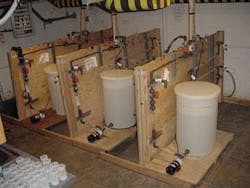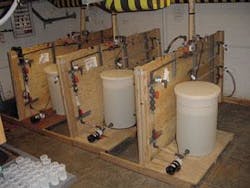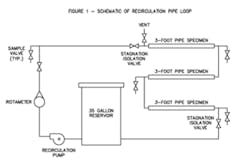By John Civardi and J. Margaret Gray
The lead and copper rule (LCR) has received renewed interest by regulators, public health officials and the news media. In 2004 there were over 50 articles in the Washington Post concerning lead in the District of Columbia’s water system and articles have appeared in news media across the nation regarding local lead and copper levels in drinking water.
In 2004 EPA reviewed the Lead and Copper Rule to determine if there was a national problem regarding elevated levels. The review found that since 2000, 96% of the systems serving more than 3,000 people were in compliance. While the EPA evaluation did not reveal a national problem, EPA identified opportunities to improve and clarify specific areas of the rule. One of the improvements which will impact the operation of treatment systems is the EPA’s proposal to require that a public water system notify the state of treatment changes 60 days prior to the change rather than 60 days after a change.
Often treatment changes that have not been sufficiently studied are the cause of water systems being out of compliance with the LCR. This rule revision will give states an opportunity to provide input on a utility’s decision, or require additional monitoring prior to a change in treatment that could affect corrosion control.
The additional time required for notification is particularly desirable now that water utilities are increasingly confronted with the need to make treatment and supply modifications to meet more stringent water quality standards. The potential exists that those modifications will increase the incidence of LCR compliance issues since they may adversely affect the corrosivity of the water. Careful evaluation of potential treatment modifications before and after implementation is the best way to minimize lead and copper levels in a distribution system.
System modifications that could impact corrosivity include:
• Change of disinfection chemicals to reduce disinfection by-products;
• Modification of coagulant chemicals to reduce total organic carbon;
• The use of alternate sources of supply to satisfy growing demands;
• Biofilm management practices within the distribution system;
• Modification of corrosion inhibitors to reduce the impact on wastewater treatment plant operations.
The traditional method of evaluating the effect of treatment changes on corrosion control has been to perform desktop studies using solubility models often followed by complicated and costly flow-through pipe loop studies. Desktop/solubility simulations may not be able to predict the actual consequences of a treatment change. As a result, physical corrosion control testing of the proposed changes becomes an essential component of the evaluation process. It provides empirical data using site specific conditions which can be used by the utility to determine if the proposed treatment changes will adversely affect corrosion.
For those utilities with distribution system corrosion problems, it is also an important evaluation tool for identifying treatment changes for reducing corrosion. In general, physical corrosion control testing is a valuable and economical tool for understanding the corrosive characteristics of water.
Corrosion Control Testing
There are two types of testing generally used for assessing the impact of water quality on corrosion: flow-through testing and static testing.
Flow-through testing refers to the continuous flowing conditions through a testing apparatus where the solution is not recirculated. This is the conventional pipe loop study. Flow through tests attempt to simulate the conditions found at the service and home plumbing. The primary disadvantage of the flow-through test is that the loops need to be operated for an extended period of time -- as much as several months -- before an accurate comparison between differing treatment techniques can be obtained.
Chemical feed in such tests is more complicated than other testing methods due to the need to continuously add chemicals requiring the use of chemical feed pumps and controls. The typical cost of a single, automated, conventional pipe loop system can be on the order of $10,000.
Static testing refers to a “no flow-through” condition. A practical form of the static test is the use of recirculation pipe loops in which a reservoir of test water is circulated through pipe segments in a closed loop over an extended period. Note that while the water is flowing through the piping segments, it is the same batch of water that is being recirculated during the holding time and therefore it represents a static test. During the recirculation period the buildup of corrosion release products in the recirculation water is measured. Recirculation pipe loops are much easier to construct and operate than the flow through testing and can provide more rapid results (within 1 to 2 months) as compared to conventional flow-through loop studies.
A typical pipe loop consists of:
• reservoir (typically a 35 gallon container),
• recirculation pump, operating at between 0.5-2 gpm,
• piping specimens representative of the field conditions of concern - for example segments of lead or copper service lines harvested from the distribution system could be used - typically 3 to 9 ft of piping is sufficient.
• sampling valves as appropriate.
Figure 1 is a schematic of a typical recirculation loop and Figure 2 is a photograph of a multiple recirculation loop set-up. The cost of the parts associated with the system is approximately $500-$1000 and the system can be fabricated in less than four hours. The space required for the system is approximately 2 ft wide by 8 ft long by 3 ft high. Because of the compact nature and low cost of the recirculation loop, multiple treatment scenarios can be evaluated.
Also, sometimes situations arise where it is desirable to perform testing at locations in the distribution system where water quality has degraded or where there may be high lead or copper levels. The recirculation loop arrangement can be made portable and is well suited for this application.
Test Protocol
Regarding operation of the loops, experience has found that a conditioning period of approximately one month is necessary for the solubility to achieve steady state. Upon completion of this conditioning period, the loops are ready to be used to analyze the proposed treatment modifications. Generally testing will consist of operating a control loop in conjunction with various treatment options.
Typical operation consists of filling the reservoir with system water and dosing chemicals to match the desired test condition. Water quality tests are performed to determine initial quality conditions such as free and total chlorine, pH, ORP, phosphate, alkalinity and hardness.
Water is then circulated through the pipe loops for five minutes before initiating stagnation. Following stagnation (generally 6 to 8 hours), water is extracted from all of the pipe loop service lines. Half of each total sample is filtered (0.45 μm filter) in order to measure both particulate and dissolved lead and/or copper. Circulation is then re-initiated for 16 hours at a rate of 2 gpm. After 16 hours, samples are again taken and analyzed for final water quality conditions such as free and total chlorine, pH, ORP, phosphate, alkalinity, hardness, lead and copper. The 24 hour cycle of stagnation and recirculation periods is then complete and a new cycle is begun with fresh system water in the reservoir and the dosing of chemicals to the desired test condition.
Case Study
In 2004, the District of Columbia Water and Sewer Authority (DCWASA) used recirculation loops as part of its efforts to select which water chemistry would successfully reduce lead corrosion in the distribution system. A recirculation pipe loop type study was selected because of the need to obtain rapid results. An initial desktop study was undertaken to determine which chemistries should be studied and then recirculation pipe loops were used to evaluate the relative performance of those identified options.
DCWASA conducted a one month pipe loop conditioning period during which the lead levels from the pipe loop water samples closely matched lead levels measured at residences with lead service lines. After the loop conditioning period and two months of data collection, the pipe loop water quality data showed that one of the treatment chemistries was performing better than the other chemistries being studied. The corrosion inhibitor identified during the pipe loop study was implemented in a hydraulically isolated portion of the distribution system for six weeks to identify any potential negative water quality impacts and then introduced system wide. The first full six month monitoring period after system wide implementation of the corrosion inhibitor was in compliance with the LCR.
It is important to note that despite the success of the treatment modification evaluations, staff at DCWASA has continued to run the pipe loop study after full-scale implementation of the identified corrosion inhibitor. They are doing this not only to further study methods of corrosion control but also to closely monitor, in a laboratory setting, the on-going effects of the current system water on lead pipes.
Through the use of recirculation loops for the past 18 months, DCWASA has demonstrated the effectiveness of physical corrosion control testing as a tool to evaluate the behavior of a distribution system before any treatment changes, to simulate a distribution system’s response to a change in treatment chemistry, and to monitor the on-going effects of changes once implemented. WW
About the Authors:
John Civardi, PE, is a Senior Associate with Hatch Mott MacDonald. He has 19 years experience in the evaluation and design of drinking water systems. Civardi has a BE and ME from the Stevens Institute of Technology. J. Margaret Gray is an engineer with Hatch Mott MacDonald. She has a BS and MS in Civil Engineering, Stanford University, and has five years experience in the evaluation of drinking water facilities. She served in the Peace Corp from 98 through 2000.





